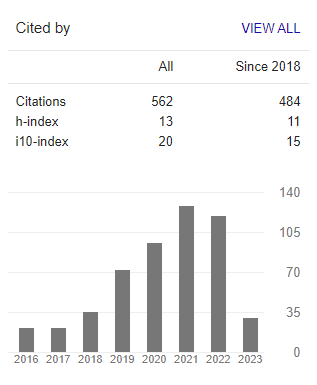REPRESENTASI EROTISME BARU DALAM KOMIK TAHILALATS TAHUN 2015-2016
Abstract
This study describes symbols and signs containing erotic elements in the Tahilalats comic by Nurfadli Mursyid. The unit of analysis based on two main components in Tahilalats. The two components are Instagram interactive feature which is used as Tahilalats medium, and comic content aspect. Interactive features include comments, and in terms of comic content including basic comic elements: panels, balloons, captions, & illustrations. Data were analyzed by using qualitative analysis method of semiotics Roland Barthes. The results of the study show symbols of new eroticism that symbolize incest, transgender, and masochism in Tahilalats. Refering to the critical paradigm, there are certain ideologies related to the background of Nurfadli as Buginese through the culture of incest, the figure of bissu, and calabai. On the other hand, the use of Instagram as a comic medium has changed the way of presentation and enjoying erotic content in comics. The presence of features in the platform Instagram also makes the netizens play a major role in constructing erotic content in the Tahilalats.
To cite this article (7th APA style):
Saputri, N. A. (2018). Representasi Erotisme Baru dalam Komik Tahilalats Tahun 2015-2016 [The Representation of New Eroticism in the Tahilalats Comic 2015-2016]. Journal Communication Spectrum, 8(2), 190-207. http://dx.doi.org/10.36782/jcs.v8i2.1854
Keywords
References
Atmowiloto, A. (1986). Komik dan Kebudayaan Nasional. Majalah Analisis Kebudayaan (hal. 109).
Barthes, R. (2012). Elemen-Elemen Semiotika. Terjemahan M. Ardiansyah. IRCiSoD.
Basyir, A. (2009, 20 Juni). Mabissu, Simbol Superioritas Waria. Media Indonesia (hal. 27).
Bauman, Z. (1998). On Postmodern Uses of Sex. Theory, Culture and Society, 15, 19-33.
Bonneff, M. (1998). Komik Indonesia. Grafika Mardi Yuana.
Castells, M. (2001). The Internet Galaxy: Reflection on the Internet, Business, and Society. Oxford University Press.
Duncan, R. & Smith, M. (2009). The Power of Comics. The Continuum International Publishing.
Fromm, E. (2007). Cinta, Seksualitas, dan Matriarki. Jalasutra.
Fuchs, C. (2008). Internet and Society: Social Theory in the Information Age. Routledge.
Graham, S. (2002). Sex, Gender, and Priest in South Sulawesi, Indonesia. IIAS Newsletter, 29, 27.
Koolhof, S. (2007). Sureq, Lontaraq, Toloq: Manuskrip dan Ragam Sastera Bugis. Jurnal Sari, 25, 171-186.
Kurnia, A. (2017). Fenomena Akun Anonim di Media Sosial sebagai Sumber Informasi dan Ekonomi. Journal Communication Spectrum, 7(2), 180-189.
McQuail, D. (2000). Mass Communication Theory. SAGE.
McLuhan, M. (1964). Understanding Media: The Extensions of Man. McGraw Hill.
McCloud, S. (2001). Making Comics. Harper.
Marx, C. (2007). Writing for Animation, Comics, and Games. Focal Press.
Maharsi, I. (2011). Komik: Dunia Kreatif Tanpa Batas. Kata Buku.
Marching, S. T. (2010). Kajian Seksualitas Kritis. Jurnal Gandrung, 1(2), 4-6.
Lister, M., Dovey, J. Giddings, S. Grant, L. & Kelly, K. (2009). New Media: A Critical Introduction. Routledge.
Oetomo, D. (2003). Memberi Suara pada yang Bisu. Pustaka Marwa Yogyakarta.
Plato (1994). Symposium (trans. Robin Waterfield. Oxford University Press.
Rahardian, B. (2015, 31 Mei). 10 Keindahan Komik Indonesia saat ini. Beng Rahadian. http://www.bengrahadian.com/
Robins, K. & Webster, F. (1999). Times of Technoculture: From the Information Society to the Virtual Life. Routledge.
Thwaites, T., Davis, L. dan Mules. W. (2009). Introducing Cultural and Media Studies: Sebuah Pendekatan Semiotika. Jalasutra.
Wieringa, S. E. (2010). Penghancuran Gerakan Perempuan, Politik Seksual di Indonesia Pasca Kejatuhan PKI. Penerbit Galangpress.
Refbacks
- There are currently no refbacks.

This work is licensed under a Creative Commons Attribution 3.0 License.
Indexed by:
Archived in:
Listed in:
INTERNATIONAL ASSOCIATION FOR MEDIA AND COMMUNICATION RESEARCH

















